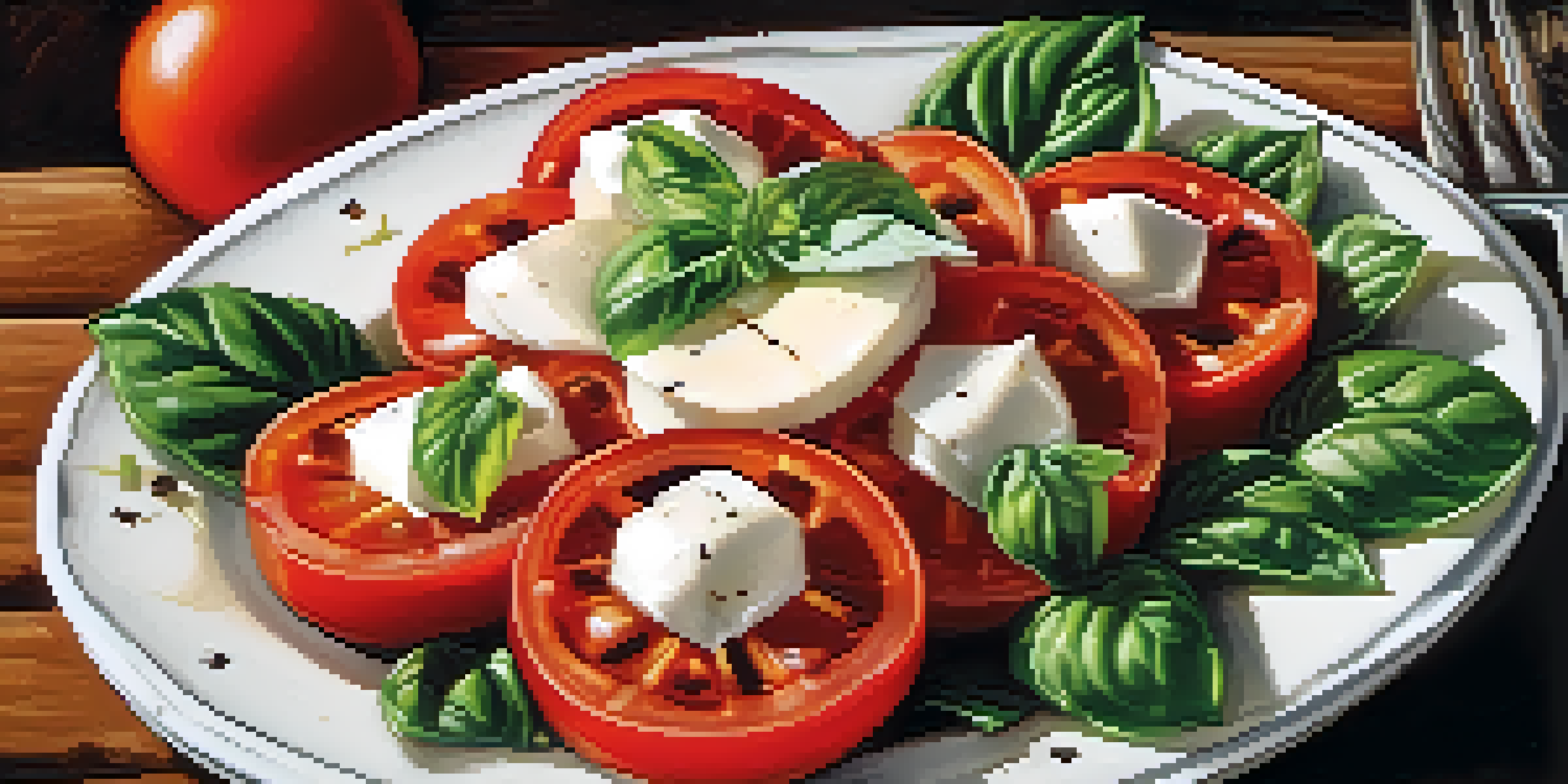Flavor Pairing: Techniques for Gourmet Ingredient Combinations

Understanding the Science of Flavor Pairing
Flavor pairing is more than just tossing ingredients together—it's a science. At its core, it involves understanding how different flavors interact, often based on their chemical compounds. For example, the sweetness of caramelized onions complements the savory notes of a rich beef stew, creating a harmonious dish that delights the palate.
Flavor is, of course, a combination of taste and smell. The aroma is what gives food its flavor.
One key concept to grasp is the idea of complementary flavors. These occur when two ingredients enhance each other's taste, making the overall dish more enjoyable. Think of how tangy citrus can brighten up the richness of a buttery fish dish; they work together beautifully, creating a well-rounded flavor profile.
On the other hand, contrasting flavors can also create excitement in your dishes. A classic example is the balance of sweet and salty, like chocolate-covered pretzels. This contrast stimulates the taste buds, resulting in a more dynamic eating experience that keeps diners coming back for more.
Exploring Flavor Families and Profiles
To master flavor pairing, it helps to understand flavor families—groups of ingredients that share similar taste characteristics. For instance, herbs like basil, mint, and cilantro often pair well with fruits due to their fresh, aromatic profiles. Knowing which ingredients belong to the same family can simplify your cooking process and lead to delicious combinations.

Flavor profiles can also be categorized into sweet, sour, salty, bitter, and umami. Understanding these categories helps you mix and match ingredients effectively. For example, pairing sweet strawberries with tangy balsamic vinegar creates a delightful contrast that elevates both flavors.
Flavor Pairing is a Science
Understanding how different flavors interact based on their chemical compounds can elevate your cooking.
Additionally, consider the textures of your ingredients. A crunchy element can add interest to a creamy dish, such as adding toasted nuts to a smooth whipped feta. This thoughtful consideration of flavor families and profiles will enhance your culinary creations.
Using Seasonality for Flavor Inspiration
Seasonality plays a crucial role in flavor pairing. Ingredients that are in season not only taste better but also complement one another naturally. For instance, ripe tomatoes in summer pair wonderfully with fresh basil and mozzarella, creating a classic Caprese salad that celebrates the season's bounty.
Cooking is like love. It should be entered into with abandon or not at all.
Consider visiting a local farmer's market for inspiration. The vibrant colors and scents of seasonal produce can ignite your creativity. As you explore, think about how these ingredients can work together to create dishes that highlight their freshness.
Incorporating seasonal ingredients not only enhances flavor but also supports local agriculture. By aligning your cooking with the seasons, you’ll discover new and exciting pairings that make your meals taste better and feel more connected to the world around you.
The Role of Aromatics in Flavor Pairing
Aromatics are essential players in flavor pairing, as they set the stage for the overall taste experience. Ingredients like garlic, onions, and ginger release compounds that can elevate a dish and create depth. For instance, sautéing garlic and onions as a base for a soup provides a fragrant foundation that enhances the final product.
In addition to traditional aromatics, spices can also play a significant role in flavor combinations. Adding a pinch of cumin to a vegetable stew can introduce a warm, earthy note that complements the natural sweetness of the veggies. This technique showcases how a small addition can transform a dish into something remarkable.
Embrace Seasonal Ingredients
Using seasonal produce not only enhances flavor but also supports local agriculture and inspires creativity in the kitchen.
Don’t overlook the power of herbs in your dishes. Fresh herbs not only add color but also introduce complex flavors that can brighten or deepen the overall taste. A sprinkle of fresh parsley can enliven a rich pasta dish, demonstrating how aromatics can bring everything together.
Experimenting with Unique Ingredient Pairings
One of the most exciting aspects of flavor pairing is the opportunity to experiment with unique combinations. Don't be afraid to think outside the box! For example, try pairing chocolate with chili for a surprising twist on dessert; the heat from the chili enhances the richness of the chocolate, creating a complex flavor experience.
Another fun combination to explore is the fusion of sweet and savory elements. Imagine a pizza topped with figs and prosciutto, where the sweetness of the figs contrasts beautifully with the saltiness of the prosciutto. This playful approach can lead to delightful culinary discoveries.
Keep a journal of your culinary experiments. Note which combinations work well and which don’t, and use these observations to refine your palate. Over time, you'll develop a sense for which flavors can coexist harmoniously, allowing you to create gourmet dishes with confidence.
Cultural Influences on Flavor Pairing
Cultural cuisines offer a treasure trove of flavor pairing techniques. Different regions have unique ingredient combinations that have been perfected over time. For example, the combination of soy sauce and ginger in Asian cuisine creates a flavorful base for many dishes, showcasing how cultural traditions shape our understanding of flavor.
Exploring international dishes can inspire you to incorporate new flavors into your own cooking. Consider how Mediterranean dishes often celebrate the pairing of olives, feta, and tomatoes, creating vibrant, fresh meals. By embracing these cultural influences, you can expand your culinary repertoire and impress your guests.
Balance is Key in Cooking
Achieving a well-rounded dish requires balancing flavors, ensuring that no single element overwhelms the others.
Don't hesitate to blend techniques from various cultures in your kitchen. Creating fusion dishes can lead to exciting and delicious outcomes. For instance, try adding a hint of curry to a classic Italian risotto, merging flavors in a way that’s both innovative and satisfying.
The Importance of Balancing Flavors
Balancing flavors is crucial for achieving a well-rounded dish. Too much of one flavor can overpower others, leading to an unbalanced and unenjoyable experience. For example, if a dish is overly salty, it might mask the sweetness of a component that could have added depth.
To achieve balance, consider the overall flavor profile of your dish. If you're working with a rich sauce, think about incorporating a splash of acidity—like lemon juice or vinegar—to brighten it up. This simple trick can transform a heavy dish into something vibrant and appealing.

Taste as you cook! This practice allows you to adjust flavors on the fly, ensuring that each element is in harmony. With a little practice, you'll develop an instinct for balancing flavors, creating gourmet dishes that are sure to impress.